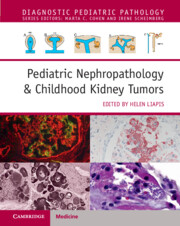Book contents
- Pediatric Nephropathology & Childhood Kidney Tumors
- Diagnostic Pediatric Pathology
- Pediatric Nephropathology & Childhood Kidney Tumors
- Copyright page
- Dedication
- Contents
- Contributors
- Preface
- Section 1 Normal and Abnormal Human Kidney Development
- Section 2 Glomerular Diseases
- Chapter 3 Idiopathic and Hereditary Proteinuric Glomerular Diseases
- Chapter 4 Haematuric Glomerular Diseases (Collagenopathies)
- Chapter 5 Immune Complex Mediated Glomerular Diseases
- Chapter 6 Inherited Metabolic Diseases Affecting the Kidney
- Chapter 7 Glomerular Diseases with Fibrillary Deposits
- Chapter 8 Mitochondrial Diseases in the Pediatric Kidney
- Section 3 Tubulointerstitial Diseases
- Section 4 Vascular Diseases
- Section 5 Infectious Diseases
- Section 6 Cystic Diseases
- Section 7 Solid Tumors of the Kidney
- Section 8 Transplant Pathology of the Kidney
- Index
- References
Chapter 8 - Mitochondrial Diseases in the Pediatric Kidney
from Section 2 - Glomerular Diseases
Published online by Cambridge University Press: 10 August 2023
- Pediatric Nephropathology & Childhood Kidney Tumors
- Diagnostic Pediatric Pathology
- Pediatric Nephropathology & Childhood Kidney Tumors
- Copyright page
- Dedication
- Contents
- Contributors
- Preface
- Section 1 Normal and Abnormal Human Kidney Development
- Section 2 Glomerular Diseases
- Chapter 3 Idiopathic and Hereditary Proteinuric Glomerular Diseases
- Chapter 4 Haematuric Glomerular Diseases (Collagenopathies)
- Chapter 5 Immune Complex Mediated Glomerular Diseases
- Chapter 6 Inherited Metabolic Diseases Affecting the Kidney
- Chapter 7 Glomerular Diseases with Fibrillary Deposits
- Chapter 8 Mitochondrial Diseases in the Pediatric Kidney
- Section 3 Tubulointerstitial Diseases
- Section 4 Vascular Diseases
- Section 5 Infectious Diseases
- Section 6 Cystic Diseases
- Section 7 Solid Tumors of the Kidney
- Section 8 Transplant Pathology of the Kidney
- Index
- References
Summary
In general, kidney disease is not a very common feature of mitochondriopathies but tends to be more prevalent in children than adults. Overall, the spectrum of kidney disease in a context of multi-organ mitochondrial disease is quite variable, and diagnostic assessment with a kidney biopsy is indispensable to establish the diagnosis. Clinically, most mitochondrial diseases with renal manifestation will cause tubular dysfunction, ranging from renal tubular acidosis to overt Fanconi syndrome (aminoaciduria, hyperuricemia and electrolyte imbalances); rarely, proteinuria and nephrotic syndrome can be a sign. Chronic kidney disease and end-stage kidney disease are the usual outcomes. The two most common mitochondrial diseases that also have renal involvement are Leigh syndrome and mitochondrial encephalomyopathy with lactic acidosis and stroke-like episodes (MELAS) syndrome. Notably, CoQ10 deficiency presents with classic FSGS and proteinuria. Other findings include proximal tubulopathy/granular tubular inclusions (large mitochondria found on EM) which clinically correspond to overt De Toni–Debré–Fanconi syndrome.
- Type
- Chapter
- Information
- Pediatric Nephropathology & Childhood Kidney Tumors , pp. 171 - 180Publisher: Cambridge University PressPrint publication year: 2023



